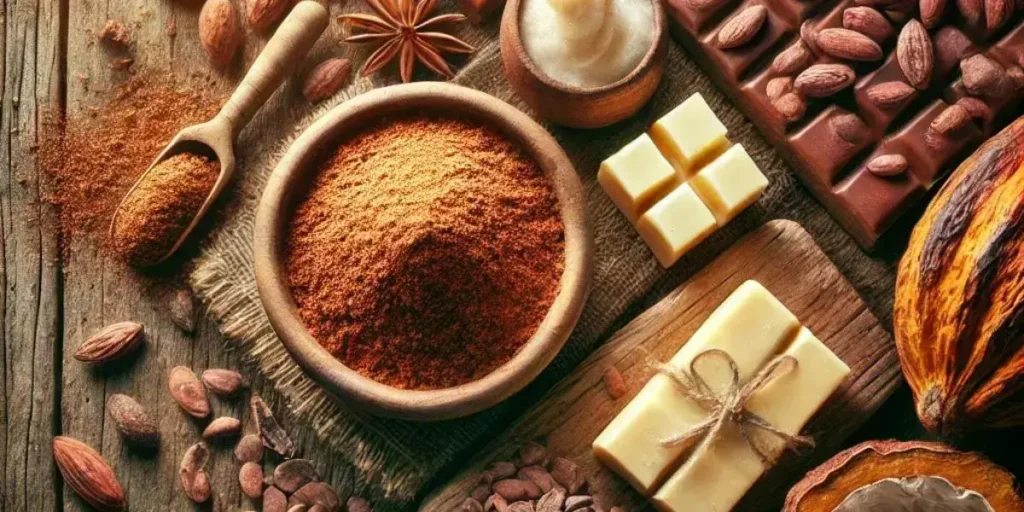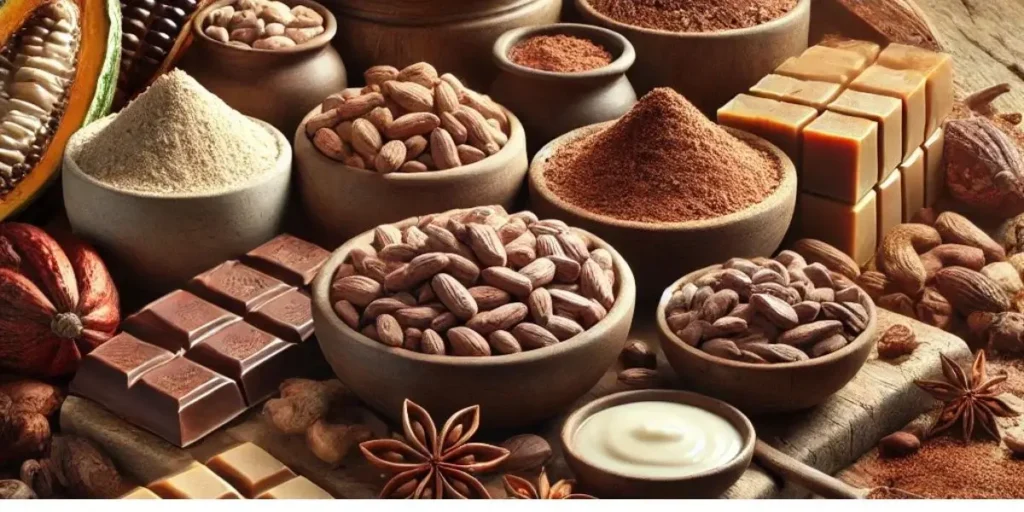Cacao powder, made from raw beans, is a popular choice for those looking for a gentle boost of energy. Unlike coffee or tea, cacao contains small amounts of caffeine, making it a mild option for an energizing effect.
What sets cacao apart is its natural inclusion of theobromine, a stimulant known for its soothing qualities. This combination creates a significant yet smoother boost compared to caffeinated beverages, with fewer jitters often associated with stronger drinks.
From my own experience, the subtle buzz from cacao provides just the right amount of motivation without the abrupt crash that comes with more intense stimulants. For anyone wondering about its caffeine levels, it’s interesting to note that a tablespoon of cacao contains 12.4 milligrams of caffeine, according to the USDA.
Whether enjoyed as a dessert-friendly treat or as part of a morning routine, cacao offers a balanced and satisfying energy source for those who cherish its rich flavor and historical significance.
Does Cacao Have Caffeine?
Yes, cacao contains caffeine, but in much smaller amounts than coffee or tea. Raw cacao powder contains approximately 12-15 mg of caffeine per tablespoon, while cacao nibs have about 4.6 mg per teaspoon. An 8-ounce cup of coffee has 95-120 mg of caffeine, approximately 8 times more than cacao.
Fun Facts About Cacao!
- Cacao beans are the raw form from which chocolate is made.
- Yes, cacao naturally contains both caffeine and theobromine.
- Theobromine is a milder stimulant than caffeine, also found in cacao.
- The caffeine content in cacao is generally much lower than in coffee.
The caffeine content in cacao varies by origin and processing method. South American cacao varieties typically contain twice as much caffeine as West African varieties. Ceremonial cacao paste provides 10-25 mg of caffeine per ounce, making it a gentle alternative to traditional caffeinated beverages.
Cacao’s primary stimulant is theobromine, not caffeine. This compound provides sustained energy without the jittery effects associated with coffee. Theobromine works synergistically with cacao’s natural fats to slow caffeine absorption, creating a smoother, longer-lasting energy boost.
Recent laboratory testing reveals that cacao’s caffeine behaves differently than coffee caffeine due to cacao butter content, which modulates absorption rates. This makes cacao suitable for caffeine-sensitive individuals seeking mild stimulation without energy crashes or sleep disruption.
For those monitoring daily caffeine intake, a typical cacao serving represents only 3-5% of the recommended 400mg daily limit, compared to coffee’s 25-30% per cup.
Caffeine Content in Cacao Powder
Cacao powder, a natural product made from raw beans, contains caffeine, though the amount can vary depending on the source and processing method. On average, raw cacao powder has about 12 milligrams of caffeine per tablespoon (5 grams). This is a relatively small yet effective source of energy.
In comparison, a cup of coffee can have around 95 milligrams of caffeine, while black tea contains 47 milligrams, and green tea offers 28 milligrams. For individuals sensitive to caffeine or those who prefer a milder alternative, cacao is a suitable choice for a gentle boost.
It’s important to distinguish between raw cacao and processed cocoa powder. Processed cocoa is heated at high temperatures, which can reduce the caffeine content and alter the flavor. In contrast, raw cacao retains its natural compounds, including theobromine and antioxidants, making it a potent source of energy.
The slightly higher concentration of these compounds in raw cacao powder makes it an excellent addition to a balanced lifestyle for those seeking a subtler pick-me-up without the intensity of other caffeinated beverages like espresso or matcha.
What is Cacao?
Often referred to as a nutritional powerhouse, cacao is the raw material used to make chocolate. Cacao beans, which are considered among the most nutritious plants on the planet, are harvested from cacao trees. These trees are grown primarily in Africa and Central America and produce pods that, when cracked open, reveal the prized beans.
Why Understanding Cacao Matters
Cacao, the primary ingredient in chocolate, is enjoyed by millions of people worldwide. Countries like the United States, Germany, Switzerland, and the United Kingdom rank as the top consumers, with the global chocolate market projected to reach $205.55 billion by 2030, driven by the increasing demand for premium and healthy options.
While cacao products are enjoyed by people of all ages, the target audience for specific items often depends on their caffeine content and nutritional profile. Dark chocolate with a high cacao percentage is typically marketed towards health-conscious adults, while milk chocolate remains more popular among children or those with a sweeter palate.
The caffeine content in chocolate varies significantly depending on the type, percentage of cacao used, and other factors. Dark chocolate generally contains more caffeine than milk chocolate, while white chocolate has little to none. Understanding specific products requires reading labels and considering the percentage of cacao, processing methods, and origin of the cacao beans.
For instance, higher percentages of cacao often indicate higher caffeine levels and the way beans are processed and roasted impacts their caffeine content. Additionally, soil composition, climate, and even the addition of ingredients like coffee or tea extracts can further increase caffeine levels in cacao products, making the content highly variable based on production and ingredient sourcing.
Who Should Limit or Avoid Cacao Powder
While the caffeine content in raw cacao powder is relatively low, individuals who are highly sensitive to caffeine should limit their intake and only consume it in moderation. In addition to caffeine, cacao contains theobromine, which has specific effects on the body. People with certain cardiovascular conditions are advised to consult their doctor before incorporating large amounts of cacao into their diet, as its components may influence heart health.
The presence of theobromine and caffeine means that cacao can affect some people differently. Those managing sensitive health conditions or looking to avoid stimulants altogether should carefully consider their consumption. For anyone with concerns, it’s wise to speak with a medical professional to understand how cacao might fit into their dietary needs without risking potential side effects.
Ingredients Found in Cacao
Cacao is a fascinating ingredient, rich in complex flavors and compounds that make it unique.

Cacao beans
These are the primary ingredients in many products derived from cacao beans. The beans are fermented, dried, and roasted to develop their rich flavor.
cocoa butter
Alongside the beans, cocoa butter, a natural fat extracted from the beans, gives cacao its smooth texture and delightful melt-in-your-mouth quality.
theobromine
What truly sets cacao apart are its natural compounds like theobromine, a bitter alkaloid that delivers effects similar to caffeine but much milder.
Caffeine
Of course, caffeine itself is naturally present in lower quantities compared to coffee, making cacao a gentle stimulant.
Flavonoids
For health enthusiasts, cacao is packed with flavonoids, potent antioxidants that may reduce inflammation and promote improved heart health.
Minerals
It’s also a source of essential minerals like magnesium, iron, zinc, and potassium, making it a nourishing addition to your diet.
Phenylethylamine
Interestingly, cacao also contains mood-boosting elements such as phenylethylamine, a compound linked to feelings of pleasure when consuming chocolate.
Tryptophan
Tryptophan is an amino acid that supports the production of serotonin, a neurotransmitter associated with mood regulation, sleep, and appetite.
Anandamide
Adding to this feel-good factor is anandamide, a fatty acid neurotransmitter that promotes a sense of well-being.
Sugar
To balance the bitterness of pure cacao, sugar is often added, creating a more palatable flavor profile.
Lecithin
Ingredients like lecithin, a natural emulsifier, improve the texture and stability of chocolate.
Vanilla
while vanilla enhances its overall taste. Depending on the product, additional ingredients such as milk, nuts, or other flavorings may also be included.
Nutritional Composition of Cacao Powder
A tablespoon of cacao powder (5.4 g) is truly nutrient-packed, offering only 21 calories while being impressively low in fat, with just 0.5 grams per serving. It contains no saturated fat or cholesterol, making it a great choice for health-conscious individuals.
When it comes to carbohydrates, cacao provides 3 grams of total carbohydrates, including 1 gram of dietary fiber, with absolutely no added sugar. These qualities make cacao a nutrient-dense addition to any diet.
Beyond its basic composition, cacao offers protein and is a meaningful source of iron, delivering 1.8 mg, or 10% of your daily value, per tablespoon. Importantly, it contains caffeine, approximately 12.4 mg per tablespoon, along with a substantial amount of theobromine at 111 mg per serving.
Raw cacao is also celebrated as the highest known source of magnesium per gram on the planet. This superfood is rich in essential vitamins, including A, B1, B2, B3, C, and E, making it a nutritional powerhouse.
The goodness packed in cacao contributes to critical body functions, such as immune support, wound healing, and regulating hormones, further solidifying its reputation as a cornerstone of health and well-being.
| Category | Nutrient | Value |
| Macronutrients | Calories | 228 kcal |
| Macronutrients | Protein | 20 g |
| Macronutrients | Total Fat | 13 g |
| Macronutrients | Saturated Fat | 8 g |
| Macronutrients | Carbohydrates | 57 g |
| Macronutrients | Sugars | 1 g |
| Macronutrients | Dietary Fiber | 33 g |
| Micronutrients | Iron | 13 mg (72% DV) |
| Micronutrients | Magnesium | 499 mg (125% DV) |
| Micronutrients | Potassium | 1524 mg (32% DV) |
| Micronutrients | Zinc | 6.8 mg (62% DV) |
| Micronutrients | Phosphorus | 734 mg (59% DV) |
| Other | Caffeine | ~230 mg |
| Other | Theobromine | ~2057 mg |
The Unique Role of Theobromine in Cacao
One of the fascinating aspects of cacao is the presence of theobromine, a natural stimulant that works differently from caffeine. Found in cacao powder, this compound belongs to the same family as caffeine but provides a gentle boost of energy.
Unlike caffeine, which primarily stimulates the central nervous system, theobromine has a milder impact and influences the cardiovascular system by promoting increased blood flow and supporting the relaxation of blood vessels. This makes theobromine’s effects smoother and less intense, creating a balanced and calming lift that enhances both mental clarity and focus throughout the day.
The combination of caffeine and theobromine in cacao offers a sustained energy boost, helping to improve mood and alertness without the sharp crashes or jittery effects often caused by higher doses of caffeine.
For individuals who are sensitive to caffeine or want to avoid it entirely, choosing products with lower percentages of cacao solids or caffeine-free alternatives may be ideal. Additionally, the theobromine content in cacao is often 5-10 times higher than its caffeine levels, making it the primary psychoactive compound.
With theobromine ranging from 1-2% by weight, a 1-ounce drink of pure cacao can deliver about 450mg, offering an uplifting experience that feels smooth and sustained.
Nutritional and Health Benefits of Cacao Powder

Raw cacao powder offers more than just caffeine content. It offers a variety of health benefits due to its rich nutrient profile, such as
Antioxidants
packed with antioxidants, especially flavonoids. These compounds help protect the body from oxidative stress and inflammation, supporting overall heart health and helping to reduce the risk of chronic diseases.
Magnesium-rich
The magnesium-rich content of cacao provides an excellent source of this vital mineral, which supports muscle function, and nerve relaxation, and even promotes restful sleep by reducing fatigue.
Mood-boosting properties
Cacao’s mood-boosting properties are also worth noting. The combination of theobromine and caffeine in cacao stimulates the production of serotonin and endorphins in the brain, helping to improve mood and reduce stress.
Lowering stress and depression
Studies, including one published in the Journal of Psychopharmacology, highlight cacao’s role in lowering stress hormones, depression, and anxiety. The compound anandamide, found in cacao, is linked to feelings of relaxation, mental stability, and emotional well-being.
Prevent cognitive decline
Additionally, regular consumption of 2-4 cups a day may help prevent cognitive decline as we age. Cacao also improves cognitive function, enhancing memory, verbal fluency, and critical thinking, making it an excellent addition to daily routines for work and day-to-day life.
How to Use Cacao Powder for a Natural Energy Boost
Because cacao powder contains a mild amount of caffeine, it serves as a natural energy booster.
Add to Smoothies
Adding it to your diet is a simple way to enjoy a gentle energy boost. For instance, you can blend a tablespoon of raw cacao powder into your morning smoothie. Its chocolatey, antioxidant-rich flavor pairs beautifully with bananas, berries, almond milk, or even leafy greens like spinach.
Make Healthy Hot Chocolate
For a cozy treat, you can make healthy hot chocolate by mixing raw cacao powder with hot water or plant-based milk. It’s a healthier, lower-caffeine alternative to traditional hot chocolate. You can sweeten it with natural sweeteners like honey, maple syrup, or coconut sugar.
Use in Baking
Additionally, use cacao powder in baking to create homemade energy bars, brownies, or cookies. Keep in mind, that raw cacao has a stronger, bitter flavor than cocoa powder, so you may need to adjust sweeteners accordingly.
Comparing Caffeine Levels: Cacao vs. Coffee

Cacao contains much less caffeine than coffee, and also contains lesser caffeine than sweet tea making it a gentler alternative for those who are more sensitive to stimulants. A tablespoon of cacao powder has around 20 milligrams of caffeine, while an eight-ounce cup of drip coffee contains between 80 and 135 milligrams.
This means unless you consume huge amounts daily, the caffeine content in cacao will not come close to the levels found in coffee. For people looking for a milder stimulant or a less stimulating morning ritual, cacao is an excellent option.
Interestingly, the amount of caffeine in cacao can vary depending on the variety, harvest timing, and how the coffee is prepared—whether as espresso, French Press, or cold brew. In its whole-food form, the fats in cacao butter help solubilize the small amount of caffeine, providing a longer-lasting high without the typical crash.
However, when consumed as a powder, these benefits are reduced because the fats are extracted during the extraction process. Additionally, cacao contains theobromine, another stimulant that promotes heart health, adding more health benefits to this unique superfood.
Energising Benefits of Cacao
Reduce Tiredness & Fatigue
Adding cacao to your day offers numerous energizing benefits. For starters, cacao powder is rich in magnesium, which helps reduce tiredness and fatigue, making it an excellent addition to your routine.
Improve Digestion
With 33% fiber, cacao powder is a fantastic way to improve digestive function and support gut health. This fiber content helps regulate digestion, promoting a healthy and balanced system.
Supports Cell Repair & Muscle Recovery
Containing 23% protein, cacao is essential for cell repair and muscle recovery, making it particularly beneficial for individuals with active lifestyles or those looking to enhance their post-workout recovery process.
Enhanced Mood
Have you ever eaten chocolate and instantly felt better? That’s because of the serotonin and endorphins in cacao, which are known to enhance mood and create a natural sense of euphoria. Adding cacao to your day is a delicious way to lift your spirits.
Skin Boosting Properties
Cacao is packed with antioxidants that help neutralize skin-damaging free radicals, improving collagen production and supporting glowy, plump skin. These skin-boosting properties make cacao a treat not just for your body but also for your beauty routine.
Exploring the Different Types of Cacao with their Caffeine Content

Cacao, the primary ingredient in chocolate, is available in several forms and variants, each with its own unique characteristics, flavors, and uses. From cacao nibs sprinkled over porridge to cacao powder used for making a delicious drink, cacao offers endless possibilities. A popular favorite is a hot cacao drink, often seen as the ultimate upgrade to a standard hot chocolate.
This warm and comforting beverage is easy to prepare by mixing raw cacao powder with hot water or milk (dairy or plant-based) and sweetening it to taste. Whether enjoyed in its nibs or as a drink, cacao is a versatile and flavorful addition to your daily routine.
Cacao Powder
Cacao powder is made by grinding roasted cacao beans and removing most of the cocoa butter. This versatile ingredient is widely used in baking, as a flavoring in beverages, and in other chocolate products. Variants like Dutched cocoa powder, also known as alkalized cocoa powder, are treated with alkalizing agents to reduce acidity, resulting in a milder flavor and darker color compared to natural cacao powder.
Criollo, Forastero, and Trinitario
The genetic varieties of cacao include Criollo, Forastero, and Trinitario. Criollo is the rarest and most prized for its delicate flavor, while Forastero is the most common and known for its stronger, robust taste. Trinitario is a hybrid of these two varieties, combining the characteristics of both for a balanced flavor.
Single-Origin Cacao
Single-origin cacao is sourced from a specific geographical region, such as Venezuela, Ecuador, or Ghana. Its unique flavor profile is influenced by factors like soil composition, climate, and processing methods, making it highly sought after by chocolate connoisseurs.
Cacao Nibs
Cacao nibs are the broken pieces of roasted beans, with their outer shell removed. They have a crunchy texture and intense chocolate flavor, making them a popular addition to baked goods, trail mixes, and snacks. Their texture and flavor offer versatility in various culinary uses.
Cacao Beans
As the seeds of the cacao fruit, cacao beans are the primary source of all cacao-based products. These beans are typically fermented, dried, and roasted before being processed into different forms such as powder or nibs, contributing to their widespread use in both chocolate production and health foods.
Cocoa Butter
Cocoa butter, the natural fat extracted from cacao beans, is a key ingredient in chocolate production. It gives chocolate its smooth texture and melt-in-your-mouth quality, making it an indispensable component in confectionery.
Raw Cacao
Raw cacao refers to cacao beans that are not roasted, often used in health food products. It is believed to retain more of the bean’s nutritional content, including its antioxidants and minerals, making it a favorite among those seeking natural and wholesome foods.
- Does NOS Energy Drink Have Caffeine? Expert Guide (2025)
- Does Bubbl’r Sparkling Water Have Caffeine? Full Breakdown In 2025
- Does Elderberry Energy Drink Contain Caffeine? Complete 2025 Review
Alternatives to Cacao and Their Caffeine Content
Mesquite
Mesquite powder, made from the pods of the mesquite tree, offers a unique flavor profile with hints of caramel, smoke, and molasses. It is naturally caffeine-free, providing a subtle sweetness that works well in beverages and baking. Mesquite is an excellent option for those looking for a distinct and complex flavor in their recipes.
Chicory Root
Chicory root is a common coffee alternative that also serves as a suitable substitute for cacao. With its slightly bitter, roasted flavor and nutty notes, it adds complexity and depth to beverages and baked goods. It is completely caffeine-free, making it perfect for those avoiding stimulants.
Maca
Although not strictly a replacement for cacao, maca root powder is a popular superfood known for its energizing properties. It features a nutty and earthy flavor, making it versatile for use in smoothies and baked goods. While maca is caffeine-free, it provides a natural boost of energy, making it a great alternative for those looking to enhance their day.
Carob
Carob is a truly caffeine-free substitute for cacao, derived from the pods of the carob tree. With its naturally sweet and slightly roasted flavor, it’s an excellent choice for those avoiding caffeine or seeking a milder taste profile. Carob is ideal for use in baking, snacks, and as a cacao replacement in hot drinks.
Decaffeinated Cacao products
Caffeine-reduced cacao products offer a way to enjoy the classic chocolatey flavor with lower caffeine levels. Specialty cocoa powders, produced by some brands, are designed for those seeking a lower caffeine intake while still enjoying the rich taste of cocoa. Though these products are not entirely caffeine-free, they provide a great alternative for people looking to balance flavor and reduced stimulation.
| Product | Caffeine Content |
| Carob Mesquite | Caffeine-free |
| Maca | Caffeine-free |
| Carob | Caffeine-free |
| Chicory Root | Caffeine-free |
Suggested Daily Cacao Intake
The recommended daily caffeine intake for healthy adults is around 400 mg. In comparison, a single tablespoon (5.4g) of cacao powder contains about 12.4 mg of caffeine, which is only 3.1% of the recommended intake. This makes cacao’s caffeine levels relatively low compared to beverages like coffee or tea, making it a gentler choice for those monitoring their stimulant consumption.
While cacao contains a smaller amount of caffeine, it also includes theobromine, a similar stimulant known for providing a gentle and sustained energy boost. The combination of these compounds contributes to the unique effects felt when consuming cacao products. However, it’s worth noting that the exact levels of caffeine and theobromine may vary slightly depending on the specific type of cacao and how it has been processed.
Conclusion
Whether you enjoy the effects of cacao’s caffeine content depends on your personal preference. If you’re seeking a stimulating beverage with less intensity than coffee, cacao can be a delightful and flavorful alternative. Along with its abundance of antioxidants and mood-boosting compounds, cacao offers a unique opportunity to indulge while also supporting your well-being.
For those who are highly sensitive to caffeine, it’s best to start with small amounts and monitor your body’s response. You might find yourself pleasantly surprised by how cacao differs from your usual caffeinated beverages, providing a gentler yet satisfying experience.
FAQs
What is responsible for the caffeine in cacao?
Cacao contains a small amount of caffeine, which is naturally present in the plant. The primary stimulant in cacao, however, is theobromine, a compound similar to caffeine but with milder, longer-lasting effects.
Does cacao provide a significant energy boost?
Cacao offers a gentle energy boost due to the presence of caffeine and theobromine. This boost is less intense but more sustained than what you might experience with coffee. Its high antioxidant and nutrient content also contributes to feelings of alertness and focus.
Can overconsumption of cacao trigger caffeine side effects?
Yes, excessive consumption of cacao can cause caffeine-related side effects in sensitive individuals. These may include jitters, anxiety, or difficulty sleeping, though cacao contains less caffeine than coffee.
Is there caffeine in raw cacao?
Yes, raw cacao contains caffeine and theobromine. The processing of cacao into chocolate products can slightly alter the levels of these compounds, but they remain naturally present in the bean.
Is there more caffeine in cacao than coffee?
No, a typical cup of coffee has significantly more caffeine than cacao. Cacao provides a gentler boost due to its combination of theobromine and a smaller dose of caffeine.
Does cacao keep you awake?
Cacao is less likely to disrupt your sleep compared to coffee, especially if consumed earlier in the day. However, if you are sensitive to caffeine, consuming cacao too close to bedtime might make it harder to fall asleep.
How does cacao caffeine compare to chocolate caffeine?
Raw cacao contains 2-3 times more caffeine than processed dark chocolate. While cacao powder delivers 12-15 mg per tablespoon, the same amount of cocoa powder provides only 4-8 mg. Processing removes natural caffeine during chocolate manufacturing.
Can you drink cacao before bed?
Cacao’s low caffeine content makes evening consumption generally safe for most people. However, theobromine can provide gentle stimulation for 4-6 hours. Those highly sensitive to stimulants should avoid cacao within 3 hours of bedtime.
Is cacao safe for caffeine-sensitive people?
Most caffeine-sensitive individuals tolerate cacao well due to its minimal caffeine content. The theobromine provides alertness without typical caffeine side effects like jitters or crashes. Start with little amounts (1 teaspoon) to assess individual tolerance.




